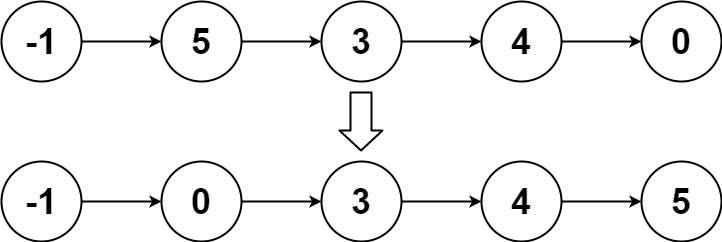给你链表的头结点 head ,请将其按 升序 排列并返回 排序后的链表 。
示例 1:

输入:head = [4,2,1,3]
输出:[1,2,3,4]
示例 2:

输入:head = [-1,5,3,4,0]
输出:[-1,0,3,4,5]
示例 3:
输入:head = []
输出:[]
方法一:使用每个节点的值进行排序,再根据 val 创建节点,返回新列表
执行 12 ms
List<Integer> valueList = new ArrayList<Integer>();
ListNode cur = head;
while (cur != null) {
valueList.add(cur.val);
cur = cur.next;
}
Collections.sort(valueList);
ListNode dummy = new ListNode();
ListNode tail = dummy;
for (int val : valueList) {
tail.next = new ListNode(val);
tail = tail.next;
}
return dummy.next;
}
方法二:list 加入 node,写比较器
执行 291 ms
List<ListNode> nodeList = new ArrayList<ListNode>();
ListNode cur = head;
while (cur != null) {
nodeList.add(cur);
cur = cur.next;
}
Collections.sort(nodeList, new Comparator<ListNode>() {
public int compare(ListNode node1, ListNode node2) {
return node1.val - node2.val;
}
});
ListNode dummy = new ListNode();
ListNode tail = dummy;
for(int i = 0; i < nodeList.size(); i++) {
tail.next = nodeList.get(i);
tail = tail.next;
System.out.print(tail.val);
}
tail.next = null;
return dummy.next;
方法三:自顶向下归并排序
class Solution {
public ListNode sortList(ListNode head) {
return sortList(head, null);
}
public ListNode sortList(ListNode head, ListNode tail) {
if (head == null) {
return head;
}
if (head.next == tail) {
head.next = null;
return head;
}
ListNode slow = head;
ListNode fast = head;
while (fast != tail) {
slow = slow.next;
fast = fast.next;
if (fast != tail) {
fast = fast.next;
}
}
ListNode mid = slow;
ListNode list1 = sortList(head, mid);
ListNode list2 = sortList(mid, tail);
ListNode sorted = merge(list1, list2);
return sorted;
}
public ListNode merge(ListNode head1, ListNode head2) {
ListNode dummyHead = new ListNode(0);
ListNode temp = dummyHead, temp1 = head1, temp2 = head2;
while (temp1 != null && temp2 != null) {
if (temp1.val <= temp2.val) {
temp.next = temp1;
temp1 = temp1.next;
} else {
temp.next = temp2;
temp2 = temp2.next;
}
temp = temp.next;
}
if (temp1 != null) {
temp.next = temp1;
} else if (temp2 != null) {
temp.next = temp2;
}
return dummyHead.next;
}
}




 浙公网安备 33010602011771号
浙公网安备 33010602011771号